Denon AVR-X6800H
Product Name: Denon AVR-X6800H
Product Description: 11.4 CH 8K AV Receiver
-
Design - 9/10
9/10
-
Audio Quality - 9.5/10
9.5/10
-
Inputs / Ports - 9.4/10
9.4/10
-
OS, Apps and Features - 9.3/10
9.3/10
-
Price / Quality - 8.8/10
8.8/10
Summary
Reviewed at $3,499.00
Pros
- Amazing cinematic performance
- Plenty of connectivity options
- Huge list of extras and features
- Dirac Live support
Cons
- No front HDMI port
- Reduction of legacy ports
- No backlit remote
- Increased price
Cheapest Places to Buy :
*We are a reader-supported website. When you buy through links on our site, we may earn a small affiliate commission at no extra cost to you. Home Media Entertainment does not accept money for reviews.*
Introduction
Denon has been steadily upgrading their entire AV receivers lineup year after year. After taking a close look at their refreshed S-series it was time to go higher in the performance ladder. And so today in our Denon AVR-X6800H review we finally have in our hands Denon’s latest 11 channels AV receiver.

The AVR-X6800H was announced at the 2023 CEDIA expo in September and is basically a refreshed model of their previous AVR-X6700H. This came out back in 2020 and was actually the first 8K AV receiver by Denon. Denon had some time to work on this unit, so we were curious to see if all the wait was well worth it.
The new Denon AVR-X6800H is still an 11 channels AV receiver with 140 watts of power output and supports all the usual audio formats. But Denon made a few additions and improvements that brings the AVR-X6800H in line with all the other new AV receivers in their premium category.
But these additions has also an effect on the actual price. Which has gone up since the time of the AVR-X6700H. Are the changes Denon made worth the extra price? This is what we are here to find and more. So without further delay let’s start our analysis.
Design
Looks and Dimensions
The Denon AVR-X6800H maintains the familiar Denon aesthetic, with no noticeable changes in design compared to its predecessor, the AVR-X6700H. If you were hoping for a new look it seems you will have to wait a bit longer for that.
Measuring 17.1″ x 15.3″ x 9.3″ (434 mm x 389 mm x 236 mm), the AVR-X6800H shares the same dimensions as the AVR-X6700H, as it utilizes the same chassis. However, by adjusting the dual antennas to a horizontal position, you can reduce the height to a more manageable 6.6″ (167 mm).
The only change here is its weight. As the X6800H gained a couple of pounds due to some changes in its internal amplifiers. The new unit now weights a considerable 34.4 lbs (15.6 kg) which means it requires delicate handling and good ventilation.
It is always good to invest in active cooling solutions such as the AC Infinity AIRCOM T8 to maintain optimal temperatures and alleviate concerns about overheating.

Front Layout
Staying true to its premium status, the X6800H boasts a metal front panel. This is a departure from the plastic panels in Denon’s mid and lower-tier units.
Positioned on the front face is the familiar large central display. Featuring a 2-line FLD configuration, the display is flanked by sizable knobs for volume and input selection on each side. Beneath the left knob sits a solitary power button, while the remainder of the controls are behind a flip-down door. The buttons concealed beneath provide access to Zone 2 and Zone 3 controls, navigation functions, and quick selection options.
Additionally, the front panel includes a USB port, the calibration microphone port, and the standard headphone jack. Disappointingly the front HDMI port present in the X6700H is absent here. This is a trend we saw in the mid and lower tier units. But it seems that Denon starts to do the same with some of their more expensive releases. As such a port was also missing from their new AVR-A1H behemoth. And this surely is a bad decision in our books.
Internal Hardware
We talked about the outside. But what about its internals? The AVR-X6800H may not be on the same level as the A1H. But it still boasts some pretty impressive hardware.
True to Denon’s tradition, the X6800H is equipped with high-current discrete power amplifiers boasting low-impedance drive capability. What sets the X6800H apart is its mono block power amp construction. A theoretically more efficient design compared to the amplifiers found in lower-tier units.
The AVR-X6800H uses a powerful SHARC Griffin Lite XP (2-core, 1Ghz) DSP. Which is common in many of Denon’s new AV receivers. There is also AL32 processing which is Denon’s unique digital filtering.
As for its DACs the AVR-X6800H is using two ESS ES9017S plus a Texas Instruments PCM5102A, handling all digital to analog conversion duties.

Remote
While the main unit hasn’t changed a bit, the remote is completely different from the one we saw in the AVR-X6700H. The new one is codenamed RC-1256. And is basically a variant using the same design principles all Denon remotes have lately.
The remote for the X6800H is thoughtfully laid out. With all input buttons conveniently positioned at the top, alongside dedicated controls for HEOS and Bluetooth functions. Navigation buttons and channel/volume controls are centrally located, ensuring ease of access during operation. At the bottom, you’ll find playback, quick selection, and sound mode buttons, as per standard configuration.
In terms of design, the remote is sizable. With relatively small buttons that could benefit from being slightly larger for enhanced tactile feedback. However, the generous spacing between buttons minimizes the risk of accidental commands.
One notable difference of this remote compared to others is its aluminum top, adding a touch of premium aesthetics. Unfortunately, unlike the A1H’s remote, this one does not feature a backlight function.
Audio Specifications
The receiver obviously supports all known audio formats available in the market today. This includes Dolby Atmos, DTS:X, IMAX Enhanced and Auro-3D. And here we find the first big difference compared to the X6700H as we also get MPEG-H audio and 360 Reality Audio.
MPEG-H, in particular, has gained prominence in broadcasting. With adoption in ATSC 3.0 in South Korea and DVB in select European countries. Additionally, it’s utilized by various streaming services to deliver immersive 360 Reality Audio music experiences to users worldwide.
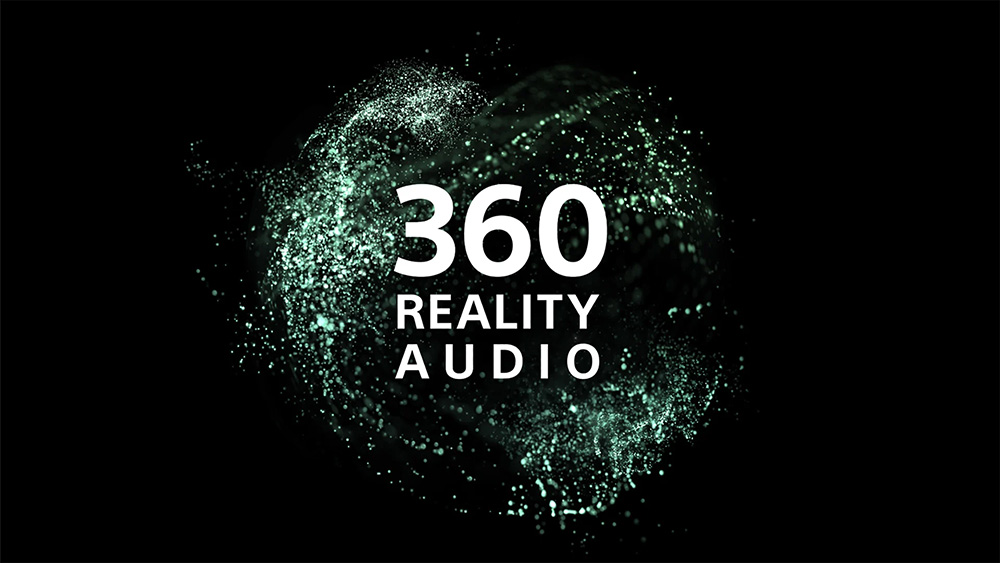
Virtual Sound & Up-mixers
In terms of up-mixing technology, the X6800H offers the familiar Dolby Surround and DTS Neural:X. These technologies work by up-converting stereo and legacy mixes, ensuring optimal utilization of all speakers within your setup.
In addition to up-mixing, the X6800H features virtual technologies such as Dolby Atmos Height Virtualization and DTS Virtual:X. These allow for the creation of virtual speakers within your room, effectively expanding the soundstage even in the absence of physical speakers.
However, it’s important to note that while these virtual technologies provide an immersive experience, they may not match the accuracy and fidelity of physical speakers. Moreover, their performance can vary depending on the room’s acoustics. And in some cases, the sound may appear over-processed, detracting from the overall listening experience.
Internal Amplification
The Denon AVR-X6800H comes with 11 channels of built-in amplification, delivering a robust power output of 140 watts per channel (8 ohm, 20 Hz – 20 kHz, 0.05% 2ch drive). It’s important to note that this power rating is applicable when driving only two channels. When all 11 channels are active, the power output per channel decreases accordingly.
The AV receiver can support up to 13 channels processing if you add an external amplifier to drive the last two channels, greatly expanding the unit’s capabilities.
One significant enhancement this time is the AVR-X6800H’s capability to drive four subwoofers independently. This is a notable improvement over the previous limit of two subwoofers. Recognizing the prevalence of multi-subwoofer setups among home theater enthusiasts, Sound United has expanded the AVR-X6800H’s functionality to accommodate this demand.

Movies Testing
Putting the Denon AVR-X6800H to the test, we decided to watch two blockbuster movies, 300 and Aquaman. Both in stunning 4K UHD with their immersive Dolby Atmos mixes. This allowed us to gauge the receiver’s performance across different genres and visual spectacles.
Front Soundstage
The Denon AVR-X6800H established an immersive front soundstage, meticulously balancing technical prowess with cinematic artistry.
Dialog and sound effects exhibited precise directionality, thanks to the receiver’s advanced processing algorithms. This created a lifelike auditory experience where every sound was precisely localized within the viewing space.
Vocals resonated with clarity, devoid of any distortion or muddiness, ensuring that every command in 300 or Aquaman was conveyed with utmost fidelity.
The receiver’s wide frequency response captured the full spectrum of audio, from the rumbling lows of battle drums to the shimmering highs of sword clashes, delivering a dynamic range that accentuates the film’s sonic tapestry.
The front soundstage expanded seamlessly beyond the physical boundaries of the room. While sound imaging was precise and three-dimensional, allowing us to perceive the spatial location of each sound element with pinpoint accuracy.
Surround Performance
Surround sound effects had fluid and precise directionality, seamlessly transitioning between channels to create a cohesive auditory panorama that enveloped us in a 360-degree sonic experience.
Even the most subtle details in the background were rendered with crystalline clarity. While the receiver’s extended frequency response captured the full range of atmospheric sounds.
Transitions between front and surround channels were seamless, without any noticeable jarring shifts. This allowed the receiver to recreate the on-screen battlefields with extreme realism.
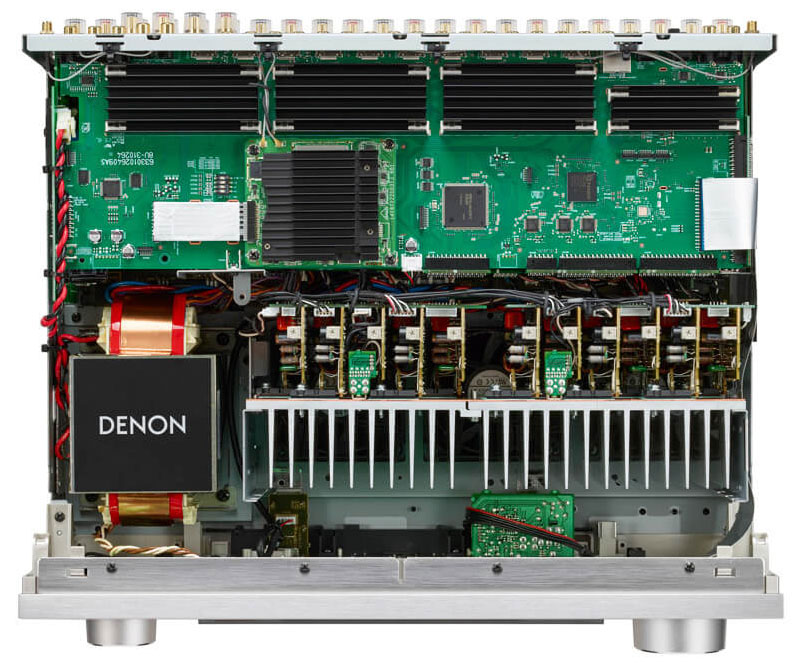
Dolby Atmos
Height channels were reproduced with exceptional precision. This allowed us to perceive sounds emanating from above, whether it’s the swoosh of flying arrows or the splash of diving dolphins adding a vertical dimension to the cinematic experience.
Sounds in the height channels were rendered with high clarity and exceptional fidelity, devoid of any distortion or timbral inaccuracies. This ensured that every sonic detail was conveyed with lifelike realism.
Bass
The receiver’s extended low-frequency response captured the full depth and richness of bass frequencies, from the earth-shaking subsonic rumbles to the chest-thumping impacts, enhancing the film’s audio with a palpable sense of weight and presence.
Bass notes were clear of any muddiness or distortion, ensuring that every thud, thump, and rumble was conveyed with visceral impact and realism.
Music Testing
In terms of music the receiver naturally comes with an extensive list of supported files and codecs. The usual low quality ones are there like MP3, WMA and AAC. But we also get High Resolution Audio support in the likes of FLAC, WAV, Apple Lossless and DSD.
For this test we used our trusted Zidoo Z9X media player in order to stream some music files to the receiver.
Front Soundstage
Changing gears into something more delicate, the Denon AVR-X6800H continued to excel. It delivered a captivating front soundstage that faithfully reproduced the intricate nuances and textures of musical performances.
Instruments and vocals exhibited precise directionality. This allowed us to perceive the spatial location of each sound element with remarkable clarity and precision.
Everything was rendered with crystalline clarity. The receiver’s extended frequency response captured the full range of musical frequencies. While sound imaging in the front soundstage was characterized by its precision and spatial accuracy.

Bass Performance
Bass notes were reproduced with clarity and definition. The low end had a visceral impact and realism, enhancing the rhythmic drive and energy of the music.
This resulted in anchoring the musical presentation with authority and precision. Whether it’s the thumping basslines of electronic dance music or the resonant low frequencies of orchestral compositions.
Different Genres
From classical to jazz, Denon’s new release adapted effortlessly to different musical genres, showcasing its versatility and adaptability. Regardless of genre, musical elements were rendered with pristine quality, allowing us to discern even the subtlest nuances and details within each performance. As a result this enhanced the overall coherence and fidelity of the music.
Performance Conclusion
In conclusion, the Denon AVR-X6800H set a new benchmark for audio excellence. It delivered a cinematic and musical experience that goes beyond the normal standards.
With its unparalleled technical prowess, including precise directionality, extended frequency response, and immersive soundstage expansion, it elevates the enjoyment of entertainment content to new heights.
Whether you’re diving into epic battles or grooving to your favorite tunes, this AV receiver offers an audio experience that will definitely captivate your senses and enhance your overall entertainment experience.
Connectivity
Ports Analysis and Layout
The receiver’s front ports include a USB port, the setup microphone port and the headphones jack. Unfortunately the front HDMI port that was present in the AVR-X6700H is missing which is a major letdown.
At the back we see that Denon also made a few notable changes compared to its predecessor.
Towards the bottom we find the 13 speaker terminals placed in a straight line which helps a lot with cable management. The terminals are of very high quality with smoke-clear resin exteriors and gold plated innards.
At the top we find 7 HDMI inputs and 3 HDMI outputs. All of them are HDMI 2.1 due to the use of a new updated HDMI board used in many top tier Denon units.
As for the rest of the connections we get 2 optical and 2 coaxial digital inputs, 1 Ethernet port and a 2nd USB for power distribution. There is also zone-2 and zone-3 pre-outs, 1 remote control input and 1 output, 3 12V triggers, an RS-232C and 4 RCA subwoofer pre-outs.
We also find 13 channels pre-outs, 6 analog stereo inputs and one more specifically for phono, two composite video inputs, one component video input and the usual FM/AM antenna inputs.
Before moving on we need to mention the differences between the AVR-X6700H and the new AVR-X6800H. The new unit gets a rear USB port for power distribution, a 3rd 12V trigger and two additional subwoofer RCA ports. And most importantly has all seven HDMI 2.1 ports support. On the other hand it loses the front HDMI input, two composite inputs and both outputs, one component input and the component output.
HDMI Specifications
The Denon AVR-X6800H comes with full HDMI 2.1 support. This means all its ports are HDMI 2.1 certified that support all the old and new exciting technologies available today.
These include 8K/60Hz and 4K/120Hz video passthrough, 40Gbps bandwidth, 4:4:4 Pure Color sub sampling, HDR10, HDR10+, Dolby Vision, Hybrid Log-Gamma (HLG), Dynamic HDR, 3D, BT.2020 pass-through, Variable Refresh Rate (VRR), Auto Low Latency Mode (ALLM) and Quick Frame Transport (QFT).

The new AVR-X6800H is using a new HDMI board that is the same one we saw in Denon’s AVR-A1H. And because this board features four secondary boards in order to accommodate the seven HDMI inputs the price of the new unit is slightly higher than its predecessor.
Obviously the new receiver can support all signals including those from a PS5 and Xbox series X. This means it can playback 4K@120Hz RGB signals that its predecessor had problems with.
For this review’s purposes we connected both our PS5 and Xbox Series X and tested both with a couple of games. We didn’t notice any problems and all signals displayed correctly on screen.
Wireless Capabilities
As for the unit’s wireless capabilities we get built-in WiFi (IEEE 802.11a/b/g/n/ac) which can connect both in 2.4GHz and 5 GHz networks. We also get Bluetooth support and it seems that Denon upgraded its module as it is now v5.4 instead of the v4.2 most Denon AV receivers came with in recent years. Unfortunately this still supports only the basic SBC codec.
OS, Apps and Features
Let’s go through all the extras the new unit has now. Being a top tier AV receiver, Denon included their entire feature list. Which means what we find in this one is almost the same as their A1H behemoth.
Audio Calibration System
First of all we will talk about the audio calibration system. Denon is once again using the Audyssey system. And as with all manufacturers they scale it accordingly to meet the price and performance standards of each of their models.
But as we have seen in some of their other top performing models, this is not alone anymore. Denon included Dirac Live, so you have the ability to choose which one you want.
With two profiles available you can even have one set up with Audyssey and one with Dirac. Hopefully Denon will add more profile slots with an update in order to give their units more flexibility.

Audyssey MultEQ XT32
Naturally the AVR-X6800H comes with the Audyssey MultEQ XT32 version which is their best and most feature complete suite. In comparison this one features the highest resolution filters which can result in higher accuracy during calibration.
The Audyssey MultEQ XT32 also comes with Dynamic Volume, Dynamic EQ, Audyssey LFC and Audyssey sub EQ HT. This version of Audyssey has the ability to analyze up to 8 different listening positions with the help of the included microphone. And creates precise digital filters in order to offer the best audio result for your particular space.
But except from the core system we also get Dynamic EQ which is a feature that is responsible for keeping the clarity and dynamic levels of audio even when you like to watch at low volume, like for night viewings for example. Dynamic Volume on the other hand is capable of balancing sudden changes and spikes in volume that could appear when there are sudden changes from TV broadcasting to commercials.
There is also Audyssey LFC that uses advanced psychoacoustic algorithms to deliver more full-range balance, including deep bass, without disturbing neighbors or people in other rooms of your home. And lastly Audyssey Sub EQ HT that provides individual DSP tailoring of each subwoofer in a multi subwoofer setup for deeper bass with improved definition.
Audyssey calibration
Going through the Audyssey calibration can be done either through the built-in wizard or if you want to dive deeper into calibrating your system then you can download the Audyssey MultEQ Editor app that is available for Android or iOS and do a more thorough setup with the help of your mobile device.
Only keep in mind that this app has a one time fee which is a shame to be honest when you already pay such a high price for the receiver. As for the built-in system, this is more than enough for most casual users as it offers almost everything you need to make very good and precise adjustments to your system.
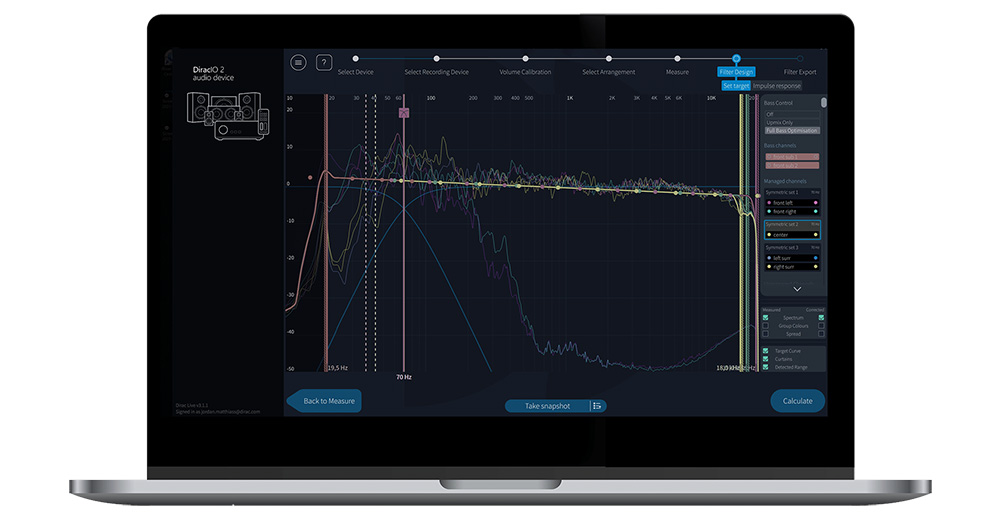
DIRAC Live
And then you have Dirac Live which Denon started adding lately in their new releases. When doing initial setup you can choose if you want to use the Audyssey calibration system or Dirac Live. Dirac Live automatically calibrates the sound in your room using your smartphone and the included wired mic. Or you can go the wireless way with the Dirac Live PC or MacOS application, and a 3rd party USB mic if what you have may be better than the one provided in the box.
What Dirac Live does is to correct both the timing and amplitude aspects of sound coloration using a mixed-phase correction filter throughout the listening area, not just a particular zone. Correction happens automatically using the proprietary app for smartphone or tablet. And it can improve staging, localization, clarity, voice intelligibility, and bass response.
The system is really powerful and you literally have everything you need in order to use it. The app can be wonky from time to time. But in general we found it very stable and the results you get, in our opinion, are far better than what the Audyssey system can do. At least without the Audyssey MultEQ Editor app.
There are various presets where you can save your configuration and also after the initial measurements you can go to each channel separately and adjust the curve any way you like so this can be particularly handy for those that seek to do micro-adjustments to the system’s own balancing.
Keep in mind that Dirac Live is now available with the additional Bass Control option. This allows for more thorough calibration of your subwoofer/subwoofers and Dirac offers a single or multiple subwoofer licenses.
Denon AVR Remote App
Denon provides another app for this AV receiver and this one comes completely free. The Denon AVR Remote app lets you control the unit with your mobile device through a nice visual interface. If you don’t like the remote it comes with, this is a nice, and most important, free alternative. The app is available for both Android and iOS devices so we suggest you give it a try to see if you like it.

User Experience
And since we mentioned the visual interface we have to talk about the updated GUI. Denon changed the UI in 2022. But the AVR-X6800H includes a few further updates that Denon made in March 2023 and we will talk in detail.
For some years now we were complaining about how old style and outdated the UI of the Denon AV receivers looked. It was as though it belonged in the early 2000s with its simple menus and 480p resolution.
The new menus are not all that different in terms of structure and layout. You still get the same list of features in a similar way to the old UI. But they bumped the resolution up to 1080p and made it look graphically more pleasing to the eye. Now it feels like it is something newer. And although it may not be as fancy like what smart TVs have, it is far better than what we were getting till now.
What is further updated is the new Manual speakers setup which combines the previous Amp Assign, Configuration and Connection screens all in one. This way you don’t have to change screens to make any necessary changes. The Crossover screen is also updated as you do not have to select speakers size anymore. You just set the crossover to the desired level.
New to this unit is also the new Bass Management which now includes the Subwoofer output, LPF to LFE and LFE distribution screens.
Voice Control
If you like a more hands free experience, the AVR-X6800H supports all known voice control platforms. As such there is support for both most known ones with Amazon Alexa and Google Assistant. But there is also support for Apple’s Siri through the Airplay 2 app and the advanced automation system Josh.ai making this receiver complete in every way.
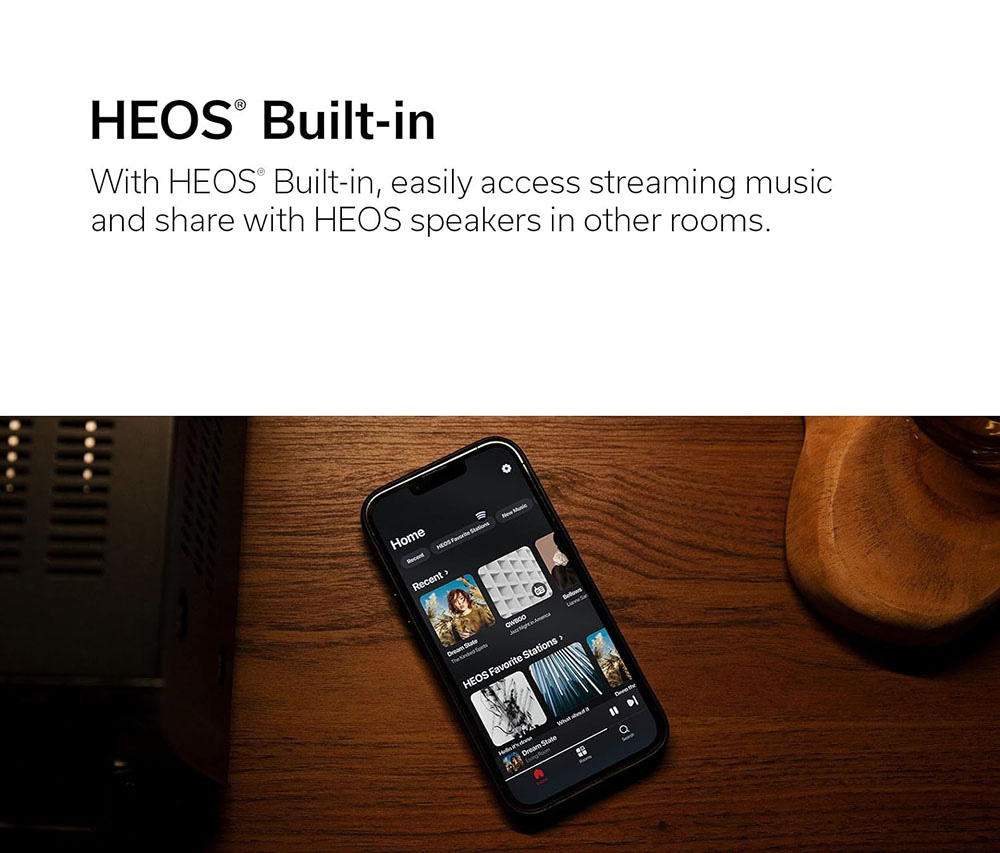
Online and Offline Streaming
For online streaming there is both HEOS and Airplay 2 you can use to stream music from one of the available online streaming services. These are TuneIn Internet Radio, Spotify, Pandora, SiriusXM and more.
All of them are available for downloading from their appropriate stores for use with your mobile device.
As for offline streaming, there are also plenty of options for you. You can stream audio from a network drive or NAS server if it happens you to have one connected to your local network.
Also with the included frontal USB port you can stream music through some connected external storage or flash drive. Lastly if you prefer a more wireless way of streaming your music there is Bluetooth available for connecting with your mobile device. If you use Apple devices then Airplay 2 can also be used to stream music wireless through it.
Bluetooth & Speakers Output
And since we mentioned Bluetooth, another function that is included in most Denon AVRs nowadays is its ability to output sound from both the main speakers and through a Bluetooth connection. The AV receiver is capable of streaming audio to Bluetooth enabled headphones for a completely silent house experience. Or it can also output sound from both its speaker terminals and to a Bluetooth headset. This can be particularly practical in case there is a member in the family that is hearing impaired.
But keep in mind that this can be used only for music and not for movies. And this happens because the Bluetooth transmitter of the AV receiver is using the SBC codec and not some more advanced variant meant for such use, like aptX Low Latency. As a result there is bound to be a small audio delay due to the Bluetooth transmission speed, making this feature ideal only for music use.

Multi-Zones Capabilities
You can also create your own multi-room environment with the use of appropriate wireless speakers. But if you prefer a wired connection the AVR-X6800H also supports Zone 2 and Zone 3 connections through its 2.0 channels pre-outs available at the back of the unit. For Zone 2 you even have the ability to choose between its pre-out connection or the dedicated Zone 2 HDMI output.
Upscaling & ECO mode
The receiver supports video upscaling to 8K resolution. What is interesting is that although the AV receiver can pass signals from its analog ports to its HDMI outputs it cannot upscale them. This is only possible if you use the HDMI inputs. For analog to HDMI pass-through you only get the signal of the source.
You also get an ECO mode that can regulate the receiver’s power usage as well as being “Roon Tested” certified.
Roon Tested
For this last one we need to clarify what this certification is. Because there are two types of certifications. Roon Ready and Roon Tested. The AVR-X6800H, as with all Denon AV receivers, is Roon Tested.
This means that while Roon will work on this unit, you will not get the highest quality possible. So for example if you use Airplay, audio quality is limited to 16 Bit/44.1kHz. Keep that in mind in case Roon is specifically important to you but also want your files to be streamed in their original quality.
HDMI-CEC
There is also HDMI-CEC. This one lets you use the TV remote to control the AV receiver, if the TV also supports this. Obviously this feature lets you use only the most basic functions of the receiver but for everyday use it can be a very time saving feature. And you can reduce the amount of remotes you have to use every time.
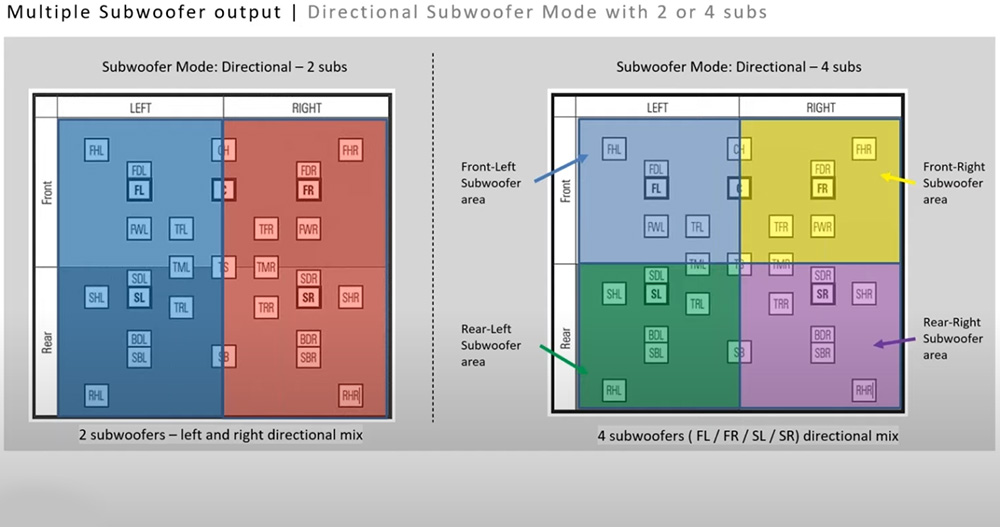
Subwoofer Modes
A neat feature is the Standard and Directional subwoofer modes. If you have a multiple subwoofers setup the Directional mode is the best choice. Because what this does is to divide your room in two, three or four areas depending the number of subwoofers connected. This will result in each subwoofer to play the bass of the speaker set to small located in that specific area.
In simple words, if you have two subwoofers, one on the left and one on the right, these will not output the same bass. If there is a cannon blasting projectiles on the right side of the screen then the right subwoofer will be more active than the left. This way you get not only surround sound directionality but also bass directionality. Which makes the whole experience even more immersive.
Custom Integration
Last but not least, the unit supports custom integration with a huge list of custom installation features. Some of the more known names are supported like Control4 SDDP, Domotz Pro and OvrC.
Compared to Other AV Receivers
The most obvious comparison is with the Denon AVR-X6700H. The new unit adds support for Sony’s 360 Reality audio and MPEG-H, it has two additional subwoofers, Dirac, 7 HDMI 2.1 ports, an advanced pre-amp mode and a refreshed GUI. On the other hand you lose the front HDMI port and a few legacy ports at the back. In our opinion although the new receiver is more expensive the number of upgrades and additions do justify the higher cost.
Next on the list is the Onkyo TX-RZ70 which sells much cheaper at $2,799. The Onkyo supports only two subwoofers and does not feature Sony’s 360 Reality audio or MPEG-H. On the other hand its Bluetooth supports the more advanced aptX codec. So in general this is a good choice, and if you are not interested in any of the Denon’s extras you can save some buck with this one.
And then we have the Yamaha RX-A8A. This comes at a price of $2,999 and compared to the Denon is missing Sony’s 360 Reality Audio and MPEG-H, it doesn’t feature DIRAC and supports only 2 subwoofers. But it does have slightly more power output at 150 watts per channel.
Lastly we need to mention the new Marantz Cinema 30. We haven’t still reviewed this one so we cannot really compare it to the Denon AVR-X6800H yet. But we plan to do a thorough analysis in the near future when we get our hands on it.
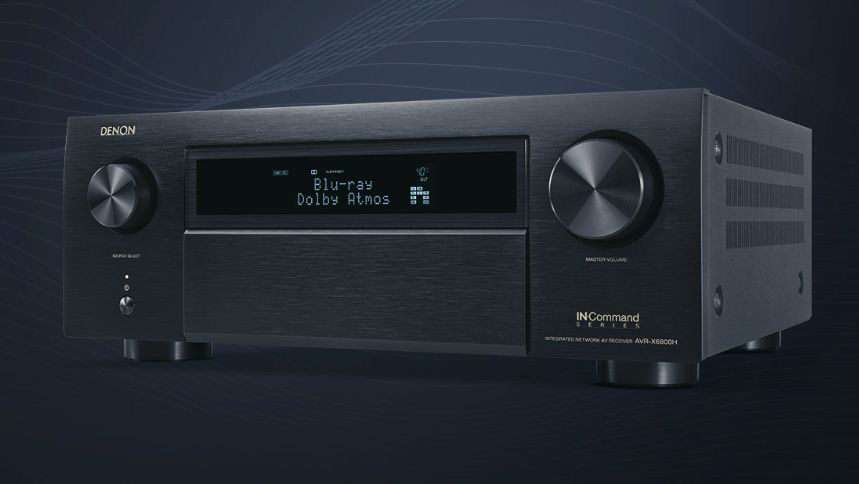
Final Thoughts
With the new unit Denon had plenty of time to fix all the problems its predecessor had. The AVR-X6700H was an amazing unit that unfortunately came at a time when the HDMI 2.1 bug was in full swing. But now Denon rectified this and made sure the new X6800H was better in every way possible.
After extensive testing we can assure you that this AVR is every bit as good as you may have heard. It has the power, the features and the cinematic qualities to deliver in every front. If you are a demanding user then there is not much better you can go with. Obviously there are better AVRs out there, but at prices that far exceed what Denon offers.
On the downsides we see that the increase in price will make a lot of people think twice. The reduction of the analog ports is unfortunate but not entirely unexpected. The omission of the front HDMI input is a big minus in our books. While we still cannot believe that such a top tier AV receiver does not come with a backlit remote.
Closing our Denon AVR-X6800H review we can say that we are totally satisfied with what we saw in this one. Its sound prowess and fidelity are undeniable and will satisfy even the most demanding of users. Its price may be a bit higher than the competition, but Denon delivered the whole package without any compromise.
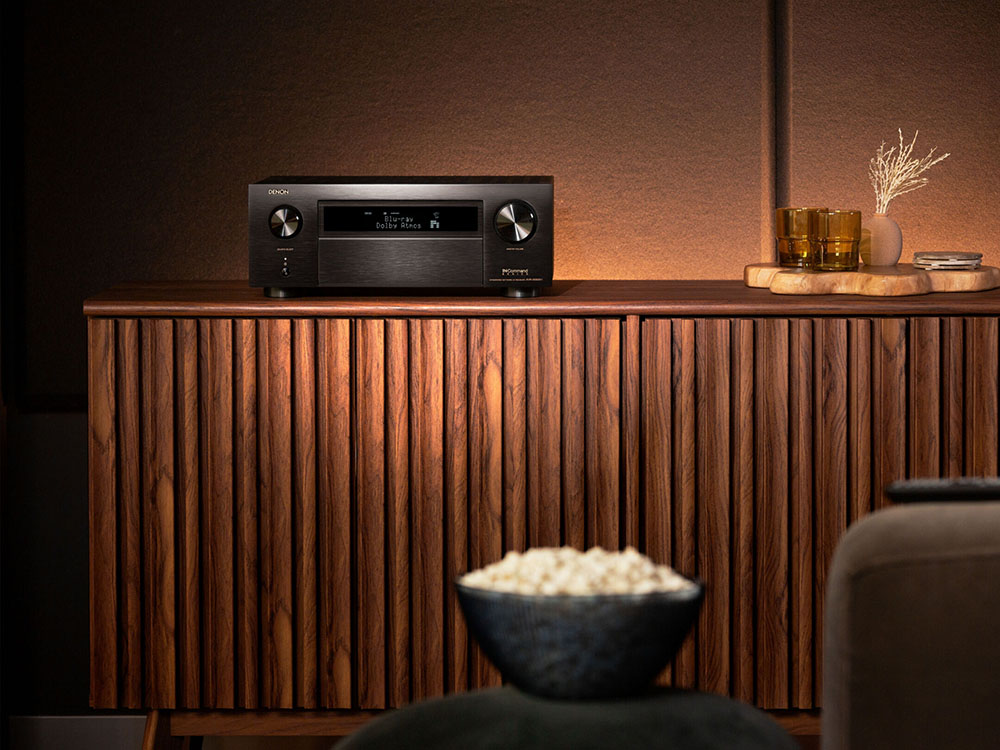
For more reviews you can check our dedicated 11 channels 8K AV Receiver reviews section or even look at our Product Reviews Table where you can find the brand and specific product you are looking for.
Cheapest Places to Buy :
*We are a reader-supported website. When you buy through links on our site, we may earn a small affiliate commission at no extra cost to you. Home Media Entertainment does not accept money for reviews.*

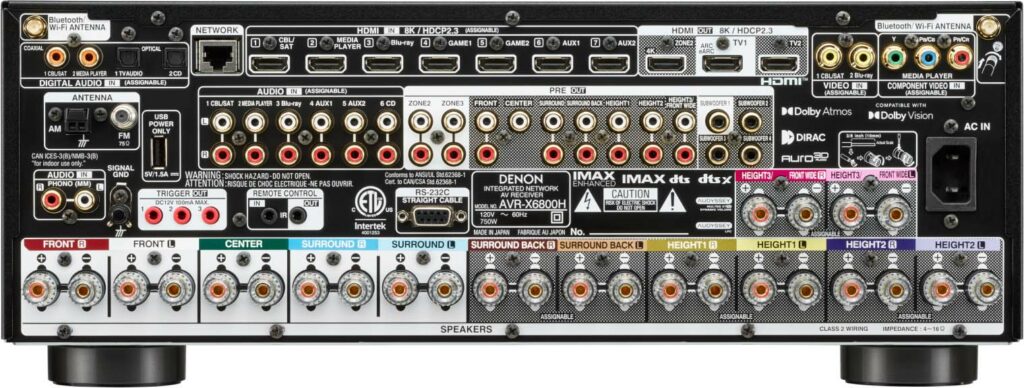




It was about time they update the X6700H. For me the full HDMI 2.1 support and DIRAC are the two most important updates in the new unit. But I agree with you on the front HDMI. As someone that likes to connect a laptop and stream some content to my home theater I find this omission a head scratching one. You pay so much money for this thing. Couldn’t they just reposition one of the rear HDMI ports to the front?
Hey there. I totally agree with you on the HDMI. I am keep telling the same thing over and over again and I would really like to hear an explanation on why they completely deleted the front one. Well, we can keep hoping.